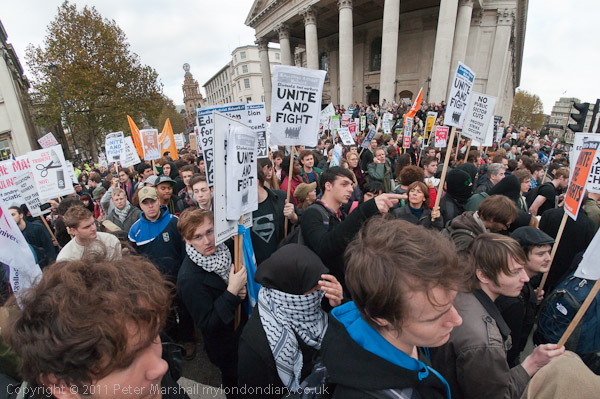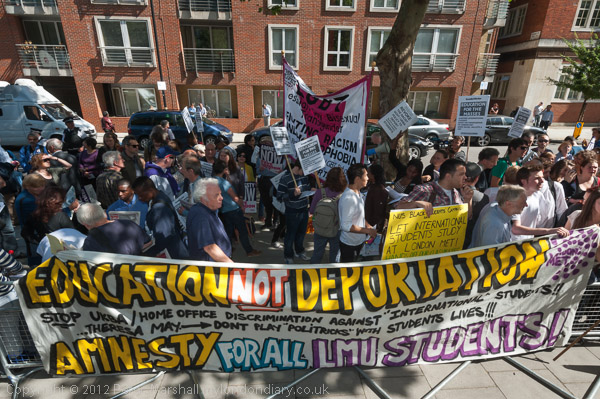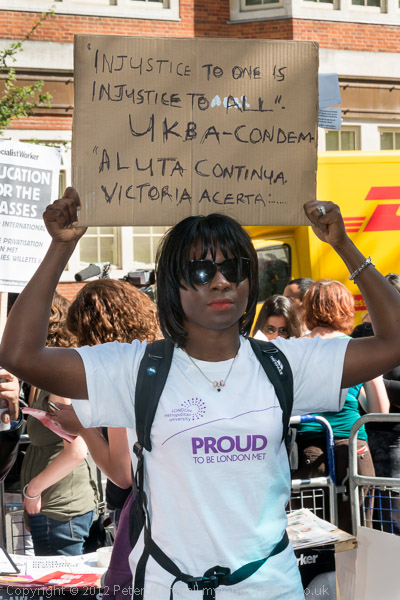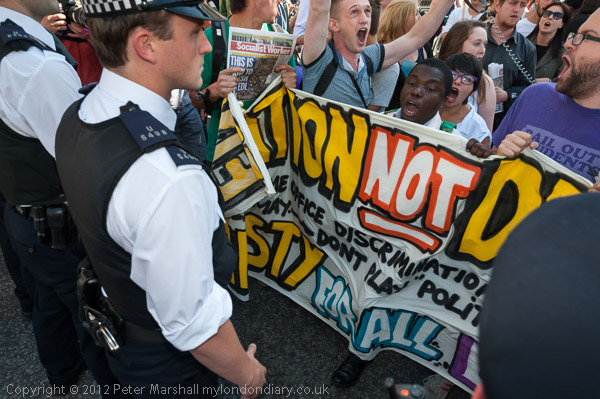Sparks And Students – On Wednesday 9th November there were protests by electricians in Southwark and police shut down most of central London to harass students as they marched to the Moorgate building of London Metropolitan University.
Sparks At The Shard – London Bridge

Around a thousand electricians – ‘sparks ‘ – marched to a protest rally at the building site for the Shard in a protest led by Unite against plans by 7 major employers to tear up national agreements and impose worse conditions and pay cuts of at least 26 %.

In 1968 major employers and the trade union had come together to set up the Electrotechnical Joint Industry Board (JIB) to set standards for the electrical industry and to provide a means of resolving the frequent disputes which were then taking place by bringing together both sides in committees with equal representation. JIB has also developed to set the standards for employment, welfare, grading and apprentice training in the electrical contracting industry.

In May 2011 seven major companies – Bailey Building Services, Balfour Beatty, Tommy Clarke, Crown House Technologies, Gratte Brothers, SES and SPIE Matthew Hall – announced that they would withdraw from the JIB pay and conditions deal and impose their own agreement known as BESNA (Building and Engineering Services National Agreement) which would enable them to replace skilled workers by those on lower grades.

Unite targeted Balfour Beatty for action as the largest company and ring-leader in the employers group and at the rally Unite General Secretary Len McCluskey announced that the union had given notice today of a strike ballot for its members employed by them. The Shard was one of Balfour Beatty’s major projects at the time, along with Crossrail.

Several hundred of the electricians had earlier held a protest in Bishopsgate and visited the Occupy London site at St Paul’s Cathedral before marching to the rally at the Shard. Police had tried to stop them at various points on their march and they arrived with a large police escort.

Before the official rally started there were speeches by rank and file trade unionist. They were followed by several Unite speakers with a final address by McClusky. Around 600 of the sparks then marched off to support the students who were protesting in London but police closed both London Bridge and Blackfriars Bridge and stopped them.

Following this and further actions by rank and file electricians Balfour Beatty, the largest of the firms in Febraury 2012 announced it was going into further talks with Unite on updating the JIB agreements and this was the end for BESNA.
More pictures on My London Diary at Sparks At The Shard.
Students March Against Cuts & Fees – Bloomsbury to Moorgate

Despite police attempts to provoke them, more than 5000 student protesters marched largely peacefully against fees increases and cuts in services. Most kept to the agreed route, from London University in Bloomsbury to London Metropolitan University in Moorgate, which was lined by thousands of police.

Students are angry about the high fees and the cuts in education – particularly the loss of the Educational Maintenace Allowances and various cuts in service, but in the early stages of the march the protesters were in a relaxed and positive mood, many talking to and joking with the police who were accompanying them.

After the police failure to stop some student fees protesters who had stormed the Tory HQ at Millbank in 2010, the police this year were determined to control events. To do so they closed all major roads in central London for hours before the march began, making it hard for many to get to the protest. There were no buses and I had to walk two miles from London Bridge and so arrived after the march started.

I could hardly see the marchers as they came down towards me on Shaftesbury Avenue, with a line of mounted police in front, followed by several lines of police on foot. Behind them were march stewards and then the main banner, behind which was a vast crowd of students and supporters carrying placards.

The march continued but with sporadic stoppages by the police for no apparent reason. But after it had come up Strand to Aldwych a snatch squad of police ran into the centre of the march, grabbed several of the many black-clad protesters, and dragged them across to the side of the road. Many around them, including me, were roughly pushed aside and I received a painful kick in my leg from one officer.

The crowd were angered and gathered around the police for some time but were persuaded by stewards to move on. People were further angered when they heard that the group of 600 electricians had been prevented from coming to join them, and the crowd took up the chant “Free the sparks!” But most then continued along the agreed route up Fetter Lane.

Police then decided to try and stop the march in what I commented “seemed like an act of complete folly“. Slowly the marchers pushed the police back from the confines of the street to the open area of Holborn Circus. Here “proceedings reached a state of comic chaos, with senior officers shouting orders to small strings of police to stop the protesters; while they were grappling with the few within reach the rest of us simply walked through the huge gaps between these lines.” Holborn Circus was really a circus.

A large group of students then ran past the police horses on Holborn Viaduct where they had withdrawn from Holborn Circus after several riders had lost control of their horses and I ran with them. Police managed to stop the rest of the marchers on Holborn Viaduct and after a short wait people decided to continue along the agreed route to Morgate without them.

I went on to talk with the people at Occupy Finsbury Circus who were worried by the huge police presence and felt they might be evicted. I thought it unlikely as with 5000 student marchers around it would be likely to spark a riot. I left and walked across the City where major roads were still closed to traffic and remained so for some hours. Later I watched videos showing students being kettled at Moorgate and individuals being attacked by snatch squads of plain clothes police who had posed as protesters after I had left.
More at Students March Against Cuts & Fees.
























